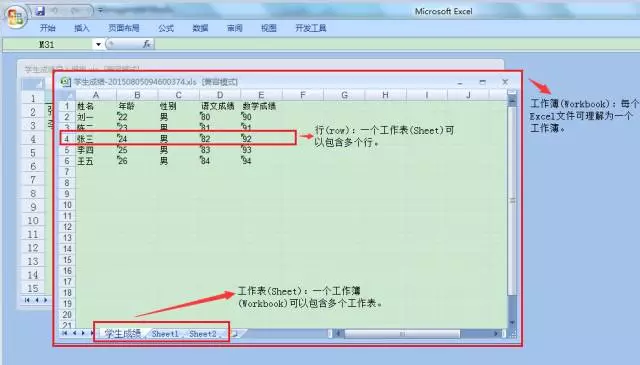Heim >Backend-Entwicklung >C#.Net-Tutorial >C#-Programmierung, Excel-Import und -Export (Quellcode-Download) (Teil 1)
C#-Programmierung, Excel-Import und -Export (Quellcode-Download) (Teil 1)
- 黄舟Original
- 2017-02-06 16:38:332477Durchsuche
In diesem Artikel wird hauptsächlich der Excel-Import und -Export in C# vorgestellt.
1. Einführung
1.1 Klassenbibliothek von Drittanbietern: NPOI
Beschreibung: NPOI ist die .NET-Version des POI-Projekts und kann für Lese- und Schreibvorgänge in Excel und Word verwendet werden.
Vorteile: Keine Installation der Office-Umgebung erforderlich.
Download-Adresse: http://npoi.codeplex.com/releases
1.2 Einführung in die Excel-Struktur
Arbeitsmappe: Jede Excel-Datei kann als eine Arbeitsmappe verstanden werden.
Blatt: Eine Arbeitsmappe kann mehrere Arbeitsblätter enthalten.
Zeile: Ein Arbeitsblatt (Blatt) kann mehrere Zeilen enthalten.

2. Excel-Import
2.1 Betriebsablauf

2.2 NPOI-Operationscode
Anleitung: Excel-Datei in Liste konvertieren
Schritte:
①Excel-Datei lesen und initialisieren eine Arbeitsmappe (Arbeitsmappe);
② Holen Sie sich ein Arbeitsblatt (Blatt) aus der Arbeitsmappe; der Standardwert ist das erste Arbeitsblatt der Arbeitsmappe;
③ Durchlaufen Sie alle Zeilen (Zeilen) des Arbeitsblatts; Standardmäßig beginnt die Durchquerung in der zweiten Zeile, und die erste Zeile (Seriennummer 0) ist der Zellenkopf.
④ Durchläuft jede Zelle (Zelle) der Zeile gemäß einem bestimmten Wert auf die Eigenschaften von Objekten.
Code:
/// 从Excel2003取数据并记录到List集合里
/// <param name="cellHeard">单元头的Key和Value:{ { "UserName", "姓名" }, { "Age", "年龄" } };</param>
/// <param name="filePath">保存文件绝对路径</param>
/// <param name="errorMsg">错误信息</param>
/// <returns>转换好的List对象集合</returns>
private static List<T> Excel2003ToEntityList<T>(Dictionary<string, string> cellHeard, string filePath, out StringBuilder errorMsg) where T : new()
{
errorMsg = new StringBuilder(); // 错误信息,Excel转换到实体对象时,会有格式的错误信息
List<T> enlist = new List<T>(); // 转换后的集合
List<string> keys = cellHeard.Keys.ToList(); // 要赋值的实体对象属性名称
try
{
using (FileStream fs = File.OpenRead(filePath))
{
HSSFWorkbook workbook = new HSSFWorkbook(fs);
HSSFSheet sheet = (HSSFSheet)workbook.GetSheetAt(0); // 获取此文件第一个Sheet页
for (int i = 1; i <= sheet.LastRowNum; i++) // 从1开始,第0行为单元头
{
// 1.判断当前行是否空行,若空行就不在进行读取下一行操作,结束Excel读取操作
if (sheet.GetRow(i) == null)
{
break;
}
T en = new T();
string errStr = ""; // 当前行转换时,是否有错误信息,格式为:第1行数据转换异常:XXX列;
for (int j = 0; j < keys.Count; j++)
{
// 2.若属性头的名称包含'.',就表示是子类里的属性,那么就要遍历子类,eg:UserEn.TrueName
if (keys[j].IndexOf(".") >= 0)
{
// 2.1解析子类属性
string[] properotyArray = keys[j].Split(new string[] { "." }, StringSplitOptions.RemoveEmptyEntries);
string subClassName = properotyArray[0]; // '.'前面的为子类的名称
string subClassProperotyName = properotyArray[1]; // '.'后面的为子类的属性名称
System.Reflection.PropertyInfo subClassInfo = en.GetType().GetProperty(subClassName); // 获取子类的类型
if (subClassInfo != null)
{
// 2.1.1 获取子类的实例
var subClassEn = en.GetType().GetProperty(subClassName).GetValue(en, null);
// 2.1.2 根据属性名称获取子类里的属性信息
System.Reflection.PropertyInfo properotyInfo = subClassInfo.PropertyType.GetProperty(subClassProperotyName);
if (properotyInfo != null)
{
try
{
// Excel单元格的值转换为对象属性的值,若类型不对,记录出错信息
properotyInfo.SetValue(subClassEn, GetExcelCellToProperty(properotyInfo.PropertyType, sheet.GetRow(i).GetCell(j)), null);
}
catch (Exception e)
{
if (errStr.Length == 0)
{
errStr = "第" + i + "行数据转换异常:";
}
errStr += cellHeard[keys[j]] + "列;";
}
}
}
}
else
{
// 3.给指定的属性赋值
System.Reflection.PropertyInfo properotyInfo = en.GetType().GetProperty(keys[j]);
if (properotyInfo != null)
{
try
{
// Excel单元格的值转换为对象属性的值,若类型不对,记录出错信息
properotyInfo.SetValue(en, GetExcelCellToProperty(properotyInfo.PropertyType, sheet.GetRow(i).GetCell(j)), null);
}
catch (Exception e)
{
if (errStr.Length == 0)
{
errStr = "第" + i + "行数据转换异常:";
}
errStr += cellHeard[keys[j]] + "列;";
}
}
}
}
// 若有错误信息,就添加到错误信息里
if (errStr.Length > 0)
{
errorMsg.AppendLine(errStr);
}
enlist.Add(en);
}
}
return enlist;
}
catch (Exception ex)
{
throw ex;
}
}2.3 Code für logische C#-Operationen
Beschreibung: Führen Sie nachfolgende Operationen an der Excel-konvertierten Liste durch
Schritte:
① Rufen Sie den 2.2-Code auf, um die Excel-Datei in List
② Überprüfen Sie die Gültigkeit von List
③Persistenten Speichervorgang für List
④返回操作结果。
代码:
public void ImportExcel(HttpContext context)
{
StringBuilder errorMsg = new StringBuilder(); // 错误信息
try
{
#region 1.获取Excel文件并转换为一个List集合
// 1.1存放Excel文件到本地服务器
HttpPostedFile filePost = context.Request.Files["filed"]; // 获取上传的文件
string filePath = ExcelHelper.SaveExcelFile(filePost); // 保存文件并获取文件路径
// 单元格抬头
// key:实体对象属性名称,可通过反射获取值
// value:属性对应的中文注解
Dictionary<string, string> cellheader = new Dictionary<string, string> {
{ "Name", "姓名" },
{ "Age", "年龄" },
{ "GenderName", "性别" },
{ "TranscriptsEn.ChineseScores", "语文成绩" },
{ "TranscriptsEn.MathScores", "数学成绩" },
};
// 1.2解析文件,存放到一个List集合里
List<UserEntity> enlist = ExcelHelper.ExcelToEntityList<UserEntity>(cellheader, filePath, out errorMsg);
#endregion
#region 2.对List集合进行有效性校验
#region 2.1检测必填项是否必填
for (int i = 0; i < enlist.Count; i++)
{
UserEntity en = enlist[i];
string errorMsgStr = "第" + (i + 1) + "行数据检测异常:";
bool isHaveNoInputValue = false; // 是否含有未输入项
if (string.IsNullOrEmpty(en.Name))
{
errorMsgStr += "姓名列不能为空;";
isHaveNoInputValue = true;
}
if (isHaveNoInputValue) // 若必填项有值未填
{
en.IsExcelVaildateOK = false;
errorMsg.AppendLine(errorMsgStr);
}
}
#endregion
#region 2.2检测Excel中是否有重复对象
for (int i = 0; i < enlist.Count; i++)
{
UserEntity enA = enlist[i];
if (enA.IsExcelVaildateOK == false) // 上面验证不通过,不进行此步验证
{
continue;
}
for (int j = i + 1; j < enlist.Count; j++)
{
UserEntity enB = enlist[j];
// 判断必填列是否全部重复
if (enA.Name == enB.Name)
{
enA.IsExcelVaildateOK = false;
enB.IsExcelVaildateOK = false;
errorMsg.AppendLine("第" + (i + 1) + "行与第" + (j + 1) + "行的必填列重复了");
}
}
}
#endregion
// TODO:其他检测
#endregion
// 3.TODO:对List集合持久化存储操作。如:存储到数据库
// 4.返回操作结果
bool isSuccess = false;
if (errorMsg.Length == 0)
{
isSuccess = true; // 若错误信息成都为空,表示无错误信息
}
var rs = new { success = isSuccess, msg = errorMsg.ToString(), data = enlist };
System.Web.Script.Serialization.JavaScriptSerializer js = new System.Web.Script.Serialization.JavaScriptSerializer();
context.Response.ContentType = "text/plain";
context.Response.Write(js.Serialize(rs)); // 返回Json格式的内容
}
catch (Exception ex)
{
throw ex;
}
}以上就是C#编程之Excel导入、导出(源码下载) (上)的内容,更多相关内容请关注PHP中文网(www.php.cn)!
In Verbindung stehende Artikel
Mehr sehen- .Net Core-Grafikverifizierungscode
- Laden der .NET Core-Konfigurationsdatei und DI-Injektion von Konfigurationsdaten
- Dokumentation zum .NET Core CLI-Tool dotnet-publish
- asp.net verwendet .net-Steuerelemente, um Dropdown-Navigationsmenüs zu erstellen
- So erhalten Sie den Namen des Controllers in Asp.net MVC

